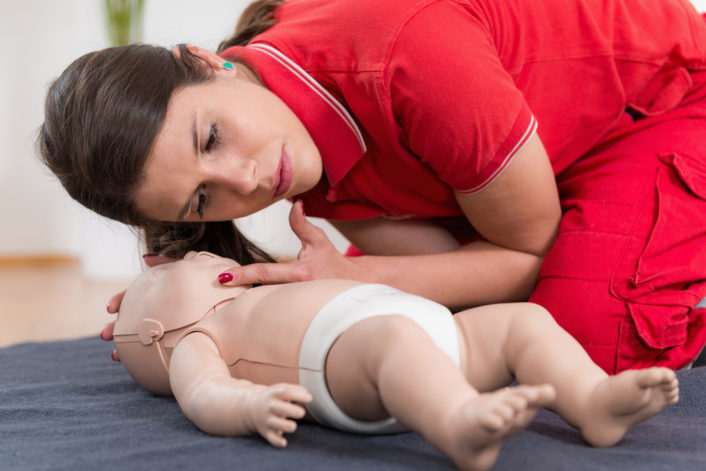Pediatric Advanced Life Support
The Pediatric Advanced Life Support (PALS) course is designed to provide healthcare professionals with a thorough understanding of the skills and procedures needed to assess and administer care within the first 10 minutes of a pediatric cardiopulmonary emergency. This course is offered fully online which enables complete flexibility to participants.
The AHA now maintains the most up-to-date recommendations online at eccguidelines.heart.org. It is recommended that you refer to this website for the most current guidelines to compliment the material that is presented in this course.
NOTE: While this course covers BLS basics, it is presumed that all participants taking this course can perform child and infant BLS correctly. If you wish to refresh your skills in this area, please refer to our BCLS course.
Course Objectives:

- Describe what is required to perform high-quality child and infant CPR and when to integrate early AED use
- Recognize patients who do and do not require immediate intervention and perform early management
- Describe the required interventions to prevent respiratory and cardiac arrest in pediatric patients
- Describe the importance of effective team dynamics, including the individual roles and responsibilities during a pediatric resuscitation
- Apply the BLS, Primary and Secondary Assessment Describe the systematic approach to pediatric assessment by using the initial impression, primary and secondary assessments and diagnostic tests
- Describe the systematic approach to pediatric assessment by using the BLS, Primary and Secondary Assessments
- Describe the needed techniques and equipment needed to support and assist with respiratory and cardiac instability
- Identify indicators of various types of shock and perform early interventions for shock treatment
- Identify cardiac arrhythmias and determine proper course of treatment, including medications, shock therapy and BCLS procedures
- Identify steps to properly manage patients post-arrest
Section 1: BCLS for Infants and Children
- Introduction to Assessing the Pediatric Patient and team dynamics
- Assessing for breathing/pulses (infant-brachial, peds-femoral, assess chest rise < 10 sec, etc.)
- Chest compressions (technique for infants vs. children, rate, depth, allowing recoil, etc.)
- BCLS with 1 and 2 or more providers
- AEDs (pad placement, etc.)
- Rescue breathing techniques (reiterating importance of breathing for children ie. Hypoxia common cause of cardiac arrest)
- Team dynamics
Section 2: Identification of Life-Threatening Illness/Injury
- Primary, Secondary and Diagnostic Assessments (ABCDEs of primary, history in secondary, testing options in diagnostics)
- Pathways to pediatric cardiac arrest
- Causes of arrest (H’s and T’s)
- Broselow tape usage
Section 3: Airway Management in Respiratory/Cardiac Arrest
- Recognition (hypoxia, hypercarbia, upper/lower airway obstruction, lung tissue disease ie pneumonias, CHF, etc.)
- Airway positioning (vitals monitoring, head tilt-chin lift, jaw thrust)
- Causes of upper airway obstruction (croup, anaphylaxis, foreign body obstruction)
- Causes of lower airway obstruction (asthma, bronchiolitis)
- Causes/management of lung disease (infection, chemical, aspiration, CHF, ARDS)
- BVM self-inflating use (mask size, pop-off valve) and flow-inflating bag use (mask size, importance of seal, monometer use)
- Suctioning
- OPA’s (sizing, placement)
- Advanced airways (LMA, ETT)
- Capnography
Section 4: Cardiac Arrhythmias
- Bradycardia (sinus, AV blocks, treatment)
- Tachyarrhythmias (sinus, SVT, V-Tach – stable vs unstable, synchronized cardioversion, medications)
- Pulseless Rhythms (V.Tach, torsades, V. Fib., PEA, defibrillation)
- Algorithms
Section 5: Recognition and Management of Shock
- Definition and Pathophysiology (compensated vs uncompensated, hypotension formula
- Types of shock (hypovolemic, distributive, cardiogenic, obstructive)
- Methods of monitoring circulatory adequacy
- Management of shock (vascular access, intraosseous, fluid resuscitation boluses, lab testing, medications) – should be done for each type shock?
Section 6: Post-Resuscitative Care
- Goals/Diagnostics
- Treatment of shock following ROSC (maintenance fluids, medications, etc.)
- Neurological Assessment


